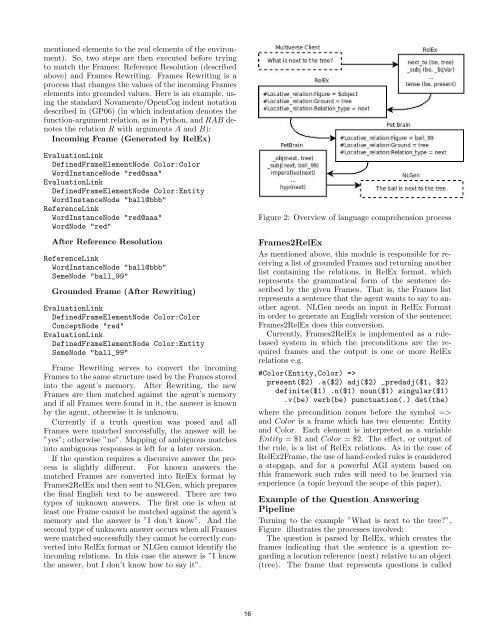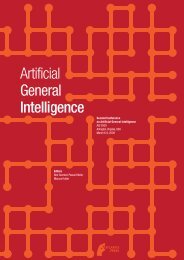Advances in Intelligent Systems Research - of Marcus Hutter
Advances in Intelligent Systems Research - of Marcus Hutter
Advances in Intelligent Systems Research - of Marcus Hutter
You also want an ePaper? Increase the reach of your titles
YUMPU automatically turns print PDFs into web optimized ePapers that Google loves.
mentioned elements to the real elements <strong>of</strong> the environment).<br />
So, two steps are then executed before try<strong>in</strong>g<br />
to match the Frames: Reference Resolution (described<br />
above) and Frames Rewrit<strong>in</strong>g. Frames Rewrit<strong>in</strong>g is a<br />
process that changes the values <strong>of</strong> the <strong>in</strong>com<strong>in</strong>g Frames<br />
elements <strong>in</strong>to grounded values. Here is an example, us<strong>in</strong>g<br />
the standard Novamente/OpenCog <strong>in</strong>dent notation<br />
described <strong>in</strong> (GP06) (<strong>in</strong> which <strong>in</strong>dentation denotes the<br />
function-argument relation, as <strong>in</strong> Python, and RAB denotes<br />
the relation R with arguments A and B):<br />
Incom<strong>in</strong>g Frame (Generated by RelEx)<br />
EvaluationL<strong>in</strong>k<br />
Def<strong>in</strong>edFrameElementNode Color:Color<br />
WordInstanceNode "red@aaa"<br />
EvaluationL<strong>in</strong>k<br />
Def<strong>in</strong>edFrameElementNode Color:Entity<br />
WordInstanceNode "ball@bbb"<br />
ReferenceL<strong>in</strong>k<br />
WordInstanceNode "red@aaa"<br />
WordNode "red"<br />
After Reference Resolution<br />
ReferenceL<strong>in</strong>k<br />
WordInstanceNode "ball@bbb"<br />
SemeNode "ball_99"<br />
Grounded Frame (After Rewrit<strong>in</strong>g)<br />
EvaluationL<strong>in</strong>k<br />
Def<strong>in</strong>edFrameElementNode Color:Color<br />
ConceptNode "red"<br />
EvaluationL<strong>in</strong>k<br />
Def<strong>in</strong>edFrameElementNode Color:Entity<br />
SemeNode "ball_99"<br />
Frame Rewrit<strong>in</strong>g serves to convert the <strong>in</strong>com<strong>in</strong>g<br />
Frames to the same structure used by the Frames stored<br />
<strong>in</strong>to the agent’s memory. After Rewrit<strong>in</strong>g, the new<br />
Frames are then matched aga<strong>in</strong>st the agent’s memory<br />
and if all Frames were found <strong>in</strong> it, the answer is known<br />
by the agent, otherwise it is unknown.<br />
Currently if a truth question was posed and all<br />
Frames were matched successfully, the answer will be<br />
”yes”; otherwise ”no”. Mapp<strong>in</strong>g <strong>of</strong> ambiguous matches<br />
<strong>in</strong>to ambiguous responses is left for a later version.<br />
If the question requires a discursive answer the process<br />
is slightly different. For known answers the<br />
matched Frames are converted <strong>in</strong>to RelEx format by<br />
Frames2RelEx and then sent to NLGen, which prepares<br />
the f<strong>in</strong>al English text to be answered. There are two<br />
types <strong>of</strong> unknown answers. The first one is when at<br />
least one Frame cannot be matched aga<strong>in</strong>st the agent’s<br />
memory and the answer is ”I don’t know”. And the<br />
second type <strong>of</strong> unknown answer occurs when all Frames<br />
were matched successfully they cannot be correctly converted<br />
<strong>in</strong>to RelEx format or NLGen cannot identify the<br />
<strong>in</strong>com<strong>in</strong>g relations. In this case the answer is ”I know<br />
the answer, but I don’t know how to say it”.<br />
Figure 2: Overview <strong>of</strong> language comprehension process<br />
Frames2RelEx<br />
As mentioned above, this module is responsible for receiv<strong>in</strong>g<br />
a list <strong>of</strong> grounded Frames and return<strong>in</strong>g another<br />
list conta<strong>in</strong><strong>in</strong>g the relations, <strong>in</strong> RelEx format, which<br />
represents the grammatical form <strong>of</strong> the sentence described<br />
by the given Frames. That is, the Frames list<br />
represents a sentence that the agent wants to say to another<br />
agent. NLGen needs an <strong>in</strong>put <strong>in</strong> RelEx Format<br />
<strong>in</strong> order to generate an English version <strong>of</strong> the sentence;<br />
Frames2RelEx does this conversion.<br />
Currently, Frames2RelEx is implemented as a rulebased<br />
system <strong>in</strong> which the preconditions are the required<br />
frames and the output is one or more RelEx<br />
relations e.g.<br />
#Color(Entity,Color) =><br />
present($2) .a($2) adj($2) _predadj($1, $2)<br />
def<strong>in</strong>ite($1) .n($1) noun($1) s<strong>in</strong>gular($1)<br />
.v(be) verb(be) punctuation(.) det(the)<br />
where the precondition comes before the symbol =><br />
and Color is a frame which has two elements: Entity<br />
and Color. Each element is <strong>in</strong>terpreted as a variable<br />
Entity = $1 and Color = $2. The effect, or output <strong>of</strong><br />
the rule, is a list <strong>of</strong> RelEx relations. As <strong>in</strong> the case <strong>of</strong><br />
RelEx2Frame, the use <strong>of</strong> hand-coded rules is considered<br />
a stopgap, and for a powerful AGI system based on<br />
this framework such rules will need to be learned via<br />
experience (a topic beyond the scope <strong>of</strong> this paper).<br />
Example <strong>of</strong> the Question Answer<strong>in</strong>g<br />
Pipel<strong>in</strong>e<br />
Turn<strong>in</strong>g to the example ”What is next to the tree?”,<br />
Figure illustrates the processes <strong>in</strong>volved:<br />
The question is parsed by RelEx, which creates the<br />
frames <strong>in</strong>dicat<strong>in</strong>g that the sentence is a question regard<strong>in</strong>g<br />
a location reference (next) relative to an object<br />
(tree). The frame that represents questions is called<br />
16













